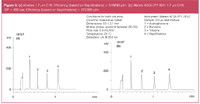Increased Efficiency and Resolution with Kinetex Core-Shell Technology
The Application Notebook
The combination of the small particle size and narrow particle size distribution coupled with the significantly shorter diffusion path provided by the Kinetex core-shell particle results in a material that yields significantly increased column efficiencies and chromatographic resolution. This is a significant benefit for separation scientists looking to increase efficiency and chromatographic resolution, especially for complex separations containing many compounds and very closely eluting compounds so that accurate identification and quantification can be achieved.
The combination of the small particle size and narrow particle size distribution coupled with the significantly shorter diffusion path provided by the Kinetex core-shell particle results in a material that yields significantly increased column efficiencies and chromatographic resolution. This is a significant benefit for separation scientists looking to increase efficiency and chromatographic resolution, especially for complex separations containing many compounds and very closely eluting compounds so that accurate identification and quantification can be achieved.
Introduction
Over the past several years column manufacturers have been introducing columns packed with smaller particle sizes — sub-2 μm and 3 μm — to take advantage of the improvements that such small particle size columns offer. The benefits offered by these columns include faster separations as a result of the reduction in the resistance to mass transfer term (C-term) in the van Deemter equation (Graph 1) allowing for higher efficiency over a wider range of linear velocity.

Graph 1: Performance of Kinetex core-shell particles.
As known, from the familiar resolution equation (below), an increase in column efficiency directly results in an increase in resolution that is equal to the square root of the increase in efficiency

k = the average value for the two peaks
α = the measurement of the spacing between the two peaks, expressed as: α = k2/k1
A comparison of the efficiency of Kinetex columns across multiple instrument platforms was performed. In addition, other small fully porous particle columns were compared as a reference against the performance observed for Kinetex core-shell technology.
Results and Discussion
Part 1: Increased efficiency
Fast LC on traditional HPLC system
The first examples [Figures 1(a) and (b)] focus on how Kinetex 2.6 μm compares with a high efficiency 3 μm material in a commonly used analytical column dimension (150 x 4.6 mm) on a traditional HPLC system (Agilent 1100). One can observe that the column efficiency, as tested by injecting a standard reversed phase column test mixture, for the Kinetex column is dramatically increased versus a Luna 3 μm C18(2) column. The Kinetex column exhibits column efficiencies greater than 225 000 plates/metre (p/m) — more than 60% greater than the high efficiency Luna 3 μm 150 x 4.6 mm column under the same isocratic mobile phase conditions. The peaks are significantly narrower and the analysis time much shorter on the Kinetex column, indicating that the expected benefits provided by smaller particle size HPLC columns (higher efficiency, faster separations and improved resolution) can be obtained even when using older model HPLC systems.

Figure 1: (a) Kinetex 2.6 μm C18; Efficiency (based on Naphthalene) = 225 900 p/m. (b) Luna 3 μm C18(2); Efficiency (based on Naphthalene) = 140240 p/m.
Fast LC on Agilent 1200 SL RRLC system
The next example [Figures 2(a) and (b)] looks at how Kinetex columns compare with other materials packed in a commonly used "fast LC" column dimension (50 x 4.6 mm) on a rapid resolution HPLC system (Agilent 1200SL) that has a higher pressure limit (600 bar) and significantly reduced dead volume as compared to the more widely available traditional HPLC systems having 400 bar pressure limits.

Figure 2: (a) Kinetex 2.6 μm C18; Efficiency (based on Naphthalene) = 264700 p/m. (b) Agilent Technologies ZORBAX 1.8 μm C18; Efficiency (based on Naphthalene) = 250880 p/m.
The Kinetex core-shell media provides notably higher column efficiencies than the fully porous Agilent Technologies ZORBAX 1.8 μm media, despite a larger particle size (2.6 μm vs 1.8 μm). This illustrates the significant benefits provided by the shorter diffusion path for the superficially porous Kinetex media on theC-term in the van Deemter equation and ultimately on the overall column efficiency. Kinetex delivers superior column efficiencies in a shorter analysis time with significantly narrower and taller peaks, which also result in an increase in sensitivity.

Figure 3: (a) Kinetex 1.7 μm C18; Efficiency (based on Naphthalene) = 318680 p/m. (b) Waters ACQUITY BEH 1.7 μm C18; BP = 450 bar, Efficiency (based on Naphthalene) = 272080 p/m.
Fast LC on Waters Acquity UPLC system
In this example, [Figures 3(a) and (b)] a comparison of the performance of Kinetex 1.7 μm C18 with the Waters ACQUITY BEH 1.7 μm C18 as tested on the Waters ACQUITY UPLC system. The Waters UPLC system was specifically designed for operation at high pressures, allowing for the use of sub-2 μm particles packed into short, narrow i.d. columns to obtain very fast separations while maintaining chromatographic resolution. The chromatograms show that the Kinetex 1.7 μm column provides a significantly higher column efficiency than the Waters Acquity 1.7 μm column (>318000 p/m vs >272080 p/m) under the same isocratic conditions for the column test mixture. Once again, this highlights the benefits of the shorter diffusion path associated with Kinetex core-shell technology, which results in a significant improvement in column efficiency, peak shape and overall analysis time.
Part 2: Increased resolution
Increased column efficiencies using a traditional HPLC system
The following examples [Figures 4(a) and (b)] show how the increased efficiency of Kinetex columns leads to improved resolution of closely eluted analytes. The first example shows the effect of increased column efficiencies using Kinetex on a standard HPLC system (Agilent 1100) for the isocratic separation of aflatoxins. This separation can be performed with good resolution of all four aflatoxins (G2, B2, G1 and B1) on a Luna 3 μm C18(2) 150 x 4.6 mm column [Figure 4(b)] in about 8 minutes. The critical pair, B2 and G1, is baseline resolved with resolution (Rs) = 1.98. Substituting Kinetex 2.6 μm C18 150 x 4.6 mm for the Luna column, on the same system and maintaining the mobile phase composition and flow rate, one can see [Figure 4(a)] that the increase in efficiency (142240 to 227233 plates/metre) obtained with the Kinetex column results in an increase in resolution from 1.98 to 2.46.

Figure 4: (a) Kinetex 2.6 μm C18. (b) Luna 3 μm C18(2).
Increased column efficiencies on Waters ACQUITY UPLC system
A final example shows the improvement on resolution and peak capacity that using Kinetex provides on a high pressure capable LC system (Waters ACQUITY UPLC). The separation of the sulpha drugs can be performed with baseline resolution of all four analytes in less than 1.5 minutes on a Waters ACQUITY BEH 1.7 μm C18 50 x 2.1 mm column [Figure 5(b)]. The measured average peak capacity is 137. The critical pair sulphathiazole and sulphamerazine are baseline resolved with Rs = 3.52. Under the same conditions with the Kinetex 1.7 μm C18 50 x 2.1 mm [Figure 5(a)], the separation is also baseline resolved in less than 1.5 minutes. However, the higher efficiency provided by the Kinetex 1.7 μm column results in an increased average peak capacity (148 vs 137) and an increase in resolution from 3.52 to 3.97.

Figure 5: (a) Kinetex 1.7 μm C18. (b) Waters ACQUITY BEH 1.7 μm C18.
In this case there is only a marginal improvement in sample throughput, as both columns provide the desired separation of the four analytes in about the same time. The real benefit is in the incremental improvement in resolution provided by Kinetex 1.7 μm particle because of the higher efficiency and average peak capacity.
Conclusion
The examples provided in this technical note illustrate the significant benefits offered by the shorter diffusion path and uniform particle size of the Kinetex core-shell media. Kinetex columns result in significantly higher column efficiencies than traditional fully porous 3 μm and sub-2 μm columns in different dimensions (4.6 and 2.1 mm i.d.) and across different HPLC and UHPLC system platforms. This increase in column efficiencies provided by the Kinetex technology results in sharper, narrower peaks and a significant increase in chromatographic resolution.

Phenomenex Inc.
411 Madrid Avenue, Torrance, California 90501, USA
tel. +1 310 212 0555 fax +1 310 328 7768
E-mail: info@phenomenex.com
Website: www.phenomenex.com

Removing Double-Stranded RNA Impurities Using Chromatography
April 8th 2025Researchers from Agency for Science, Technology and Research in Singapore recently published a review article exploring how chromatography can be used to remove double-stranded RNA impurities during mRNA therapeutics production.
The Effect of Time and Tide On PFAS Concentrations in Estuaries
April 8th 2025Oliver Jones and Navneet Singh from RMIT University, Melbourne, Australia discuss a recent study they conducted to investigate the relationship between tidal cycles and PFAS concentrations in estuarine systems, and offer practical advice on the sample preparation and LC–MS/MS techniques they used to achieve the best results.














